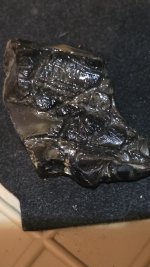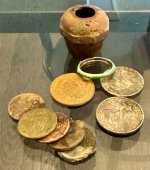Badger Bart
Sr. Member
- Mar 24, 2005
- 301
- 18
Finding a Lost Emperor in a Clay Pot October 11, 2005
by Alexander Benenson
Images courtesy the Ashmolean Museum
Forget stone, a discovery of a Roman coin in Britain proves history is set in bronze and silver.
During the chaos and confusion of the third century A.D., amid widespread disease, famine, and barbarian invasions, a brazen upstart seizes control of a breakaway state within the Roman Empire. He proclaims himself emperor only to disappear days later, his life and story lost, save for only the briefest of remarks in two fragmentary and unreliable sources. Then, an amateur treasure hunter scanning the green fields of Oxfordshire with a metal detector chances upon a small clay pot filled with more than 5,000 ancient Roman coins. A British Museum archaeologist brushing away centuries of corrosion and carefully picking apart bronze and silver pieces, discovers one exceedingly strange coin. Among the thousands of unremarkable ones, this coin carries an unfamiliar bearded face, a perplexing name, Domitianus, and most strikingly, the three letters IMP, short for imperator, or emperor.
Suddenly, the hunt was on for another coin, this one found not buried in the ground, but buried in the archives of a small provincial museum in southern France. The French coin, dug up in 1900, was deemed worthless at the time, a modern counterfeit depicting what was surely a made up emperor. Amazingly, the portrait on the supposed fake matches the strange coin in the British Museum, as does the image on the reverse side. Small characteristic markings provide the final confirmation; both coins had been struck from the same die or stamp. The French coin is not a fake, and the bearded man, not an imposter, but a lost emperor.
It sounds like the plot to the latest bestseller, but it's not. The characters, including the lost emperor, are all real. The treasure hunter is Brian Malin, a local resident of Oxfordshire, who had found a similar sized hoard just miles away in 1989, and donated it to the nearby Ashmolean Museum. In the late 1980s, when England had no coherent strategy encouraging the reporting of such finds, and every year, thousands of coins were dug up and sold without being recorded, Malin's gift was extraordinary. Since then, Britain has instituted the Treasure Act, which lays down specific rules for the treatment and sale of ancient coins. It legally binds treasure hunters to report any find of more than two coins of gold or silver over 300 years old. If the find is deemed significant, British museums are given the chance to purchase the coins at fair market value.
Malin found the Domitianus coin in a second hoard, also from Chalgrove, which is ten miles southeast of Oxford, in 2003. Because the Domitianus coin was found fused together with thousands of other coins, all inside a Roman clay jar, its authenticity was unquestionable.
As the story reached the press, the coin became source of national pride. The British paper The Times printed a picture of the coin with the caption "Is this Britain's Lost Emperor?" Archaeologists and historians were quick to temper some of the sensationalism, noting that it was highly unlikely that Domitianus, who had probably been confined to a region in southwest Germany near the Danube, had ever even seen Britain, and that the coin had made its way to Oxfordshire via trade routes or troop movements. Even so, the discovery of the coin created a buzz throughout academic circles in Britain. Christopher Howgego, the curator of ancient coins at the Ashmolean, told reporters that, "the coin is one of the most interesting Roman objects ever found in Britain."
Malin first lent the coins to the British Museum for conservation and a short exhibit entitled Buried Treasure: Finding Our Past. Then, in 2005, the hoard, dubbed Chalgrove II, was bought by the Ashmolean Museum for around $75,000. The Domitianus coin accounting for nearly a quarter of the final price tag. The high market value of such rare coins can cause problems for historians trying to distinguish fakes from the real thing. "If a usurper's coin is considered to be a unique historical 'document', its cash-value rises accordingly, thus stimulating modern forgery--all the more reason why researchers must temper enthusiasm with caution," explains Lawrence Okamura, a historian and numismatist from the University of Missouri, who was a long time skeptic of the 1900 Domitianus coin because of the poor documentation concerning its discovery and subsequent journey to the small French museum.
Even since the authenticity of the two coins has been established, the story of the rebel emperor remains frustratingly incomplete. Most of the little that we know about the lost emperor comes from two sources, The New Histories by the Greek Zosimus and the Historia Augustae, a compilation of biographical sketches of emperors penned by several unknown authors. They were both written a century after Domitianus' reign in A.D. 271, and combined, devote fewer than 30 words to the usurper. Zosimus, writing about the reign of Aurelian (A.D. 270-275), says only, "Epitimius, Urbanus, and Domitianus, were suspected of commiting treason [by Aurelian], and were immediately apprehended and punished." However, neither source says that Domitianus proclaimed himself emperor, a curious omission that also led historians to originally doubt the authenticity of the 1900 coin. Such fragmentary records of the western Roman frontier and its usurpers is often all that historians have to work with when trying to piece together the third-century. "Its' frustrating work," says Okamura, "You often wonder whether you're floundering in a closed inter-textual loop disconnected from real people and events."
The rest of the story is at: http://www.archaeology.org/online/features/coin/index.html
by Alexander Benenson
Images courtesy the Ashmolean Museum
Forget stone, a discovery of a Roman coin in Britain proves history is set in bronze and silver.
During the chaos and confusion of the third century A.D., amid widespread disease, famine, and barbarian invasions, a brazen upstart seizes control of a breakaway state within the Roman Empire. He proclaims himself emperor only to disappear days later, his life and story lost, save for only the briefest of remarks in two fragmentary and unreliable sources. Then, an amateur treasure hunter scanning the green fields of Oxfordshire with a metal detector chances upon a small clay pot filled with more than 5,000 ancient Roman coins. A British Museum archaeologist brushing away centuries of corrosion and carefully picking apart bronze and silver pieces, discovers one exceedingly strange coin. Among the thousands of unremarkable ones, this coin carries an unfamiliar bearded face, a perplexing name, Domitianus, and most strikingly, the three letters IMP, short for imperator, or emperor.
Suddenly, the hunt was on for another coin, this one found not buried in the ground, but buried in the archives of a small provincial museum in southern France. The French coin, dug up in 1900, was deemed worthless at the time, a modern counterfeit depicting what was surely a made up emperor. Amazingly, the portrait on the supposed fake matches the strange coin in the British Museum, as does the image on the reverse side. Small characteristic markings provide the final confirmation; both coins had been struck from the same die or stamp. The French coin is not a fake, and the bearded man, not an imposter, but a lost emperor.
It sounds like the plot to the latest bestseller, but it's not. The characters, including the lost emperor, are all real. The treasure hunter is Brian Malin, a local resident of Oxfordshire, who had found a similar sized hoard just miles away in 1989, and donated it to the nearby Ashmolean Museum. In the late 1980s, when England had no coherent strategy encouraging the reporting of such finds, and every year, thousands of coins were dug up and sold without being recorded, Malin's gift was extraordinary. Since then, Britain has instituted the Treasure Act, which lays down specific rules for the treatment and sale of ancient coins. It legally binds treasure hunters to report any find of more than two coins of gold or silver over 300 years old. If the find is deemed significant, British museums are given the chance to purchase the coins at fair market value.
Malin found the Domitianus coin in a second hoard, also from Chalgrove, which is ten miles southeast of Oxford, in 2003. Because the Domitianus coin was found fused together with thousands of other coins, all inside a Roman clay jar, its authenticity was unquestionable.
As the story reached the press, the coin became source of national pride. The British paper The Times printed a picture of the coin with the caption "Is this Britain's Lost Emperor?" Archaeologists and historians were quick to temper some of the sensationalism, noting that it was highly unlikely that Domitianus, who had probably been confined to a region in southwest Germany near the Danube, had ever even seen Britain, and that the coin had made its way to Oxfordshire via trade routes or troop movements. Even so, the discovery of the coin created a buzz throughout academic circles in Britain. Christopher Howgego, the curator of ancient coins at the Ashmolean, told reporters that, "the coin is one of the most interesting Roman objects ever found in Britain."
Malin first lent the coins to the British Museum for conservation and a short exhibit entitled Buried Treasure: Finding Our Past. Then, in 2005, the hoard, dubbed Chalgrove II, was bought by the Ashmolean Museum for around $75,000. The Domitianus coin accounting for nearly a quarter of the final price tag. The high market value of such rare coins can cause problems for historians trying to distinguish fakes from the real thing. "If a usurper's coin is considered to be a unique historical 'document', its cash-value rises accordingly, thus stimulating modern forgery--all the more reason why researchers must temper enthusiasm with caution," explains Lawrence Okamura, a historian and numismatist from the University of Missouri, who was a long time skeptic of the 1900 Domitianus coin because of the poor documentation concerning its discovery and subsequent journey to the small French museum.
Even since the authenticity of the two coins has been established, the story of the rebel emperor remains frustratingly incomplete. Most of the little that we know about the lost emperor comes from two sources, The New Histories by the Greek Zosimus and the Historia Augustae, a compilation of biographical sketches of emperors penned by several unknown authors. They were both written a century after Domitianus' reign in A.D. 271, and combined, devote fewer than 30 words to the usurper. Zosimus, writing about the reign of Aurelian (A.D. 270-275), says only, "Epitimius, Urbanus, and Domitianus, were suspected of commiting treason [by Aurelian], and were immediately apprehended and punished." However, neither source says that Domitianus proclaimed himself emperor, a curious omission that also led historians to originally doubt the authenticity of the 1900 coin. Such fragmentary records of the western Roman frontier and its usurpers is often all that historians have to work with when trying to piece together the third-century. "Its' frustrating work," says Okamura, "You often wonder whether you're floundering in a closed inter-textual loop disconnected from real people and events."
The rest of the story is at: http://www.archaeology.org/online/features/coin/index.html





